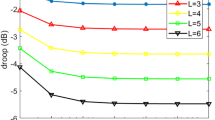Abstract
This paper proposes a novel multiplierless comb compensation filter, which has the absolute passband deviation less than 0.1 dB in the wide passband. The compensator consists of a cascade of two simple filter sections, both operating at a low rate. The magnitude characteristics of the two-component filters are synthesized as sinewave functions, in which the main design parameters correspond to the amplitudes of sinewave functions. A systematic procedure is followed to select synthesis parameters, which depend only on the number of cascaded comb filters. In particular, they are independent of the decimation factor. Comparisons with comb compensators from the literature illustrate the benefits of the proposed design.









Similar content being viewed by others
References
A. Fernandez-Vazquez, G. Jovanovic Dolecek, A general method to design GCF compensation filter. IEEE Trans. Circuits Syst. II Express Brief 56, 409–413 (2009)
A. Fernandez-Vazquez, G. Dolecek Jovanovic, Maximally flat CIC compensation filter: design and multiplierless implementation. IEEE Trans. Circuits Syst. II: Express Brief 54, 113–117 (2012)
F.J. Harris, Multirate Signal Processing for Communication Systems (Prentice Hall, New Jersey, 2004)
E. Hogenauer, An economical class of digital filters for decimation and interpolation. IEEE Trans. Acoust. Speech Signal Process. ASSP 29, 155–162 (1981)
G. Jovanovic Dolecek, Simple wideband CIC compensator. Electron. Lett. 45, 1270–1272 (2009)
G. Jovanovic Dolecek, A. Fernandez-Vazquez, Trigonometrical approach to design a simple wideband comb compensator. Int. J. Electron. Commun. 68, 437–441 (2014)
G. Jovanovic Dolecek, F. Harris, Design of wideband CIC compensator filter for a digital IF receiver. Digit. Signal Proc. 19, 827–837 (2009)
S. Kim, W.C. Lee, S. Ahn, S. Cho, Design of CIC roll-off compensation filter in a W-CDMA digital IF receiver. Digit. Signal Process. 16, 846–854 (2006)
G. Molnar, M. Vucic, Closed-form design of CIC compensators based on maximally flat error criterion. IEEE Trans. Circuits Syst. II Express Brief 58, 926–930 (2011)
M. Pecotic, G. Molnar, M. Vucic, Design of CIC compensators with SPT coefficients based on interval analysis. Proceedings of 35th IEEE International Convention MIPRO 2012, pp. 123–128 (2012)
D.E.T. Romero, G. Jovanovic Dolecek, Application of amplitude transformation for compensation of comb decimation filters. Electron. Lett. 49, 985–987 (2013)
K.S. Yeung, S.C. Chan, The design and multiplier-less realization of software radio receivers with reduced system delay. IEEE Trans. Circuits Syst. I: Regul. Pap. 51, 2444–2459 (2004)
Author information
Authors and Affiliations
Corresponding author
Additional information
This work was supported by CONACYT Grant Nos. 179587 and 264138.
Appendix
Appendix
Here, the derivation of (29) is presented in detail.
From (27), we have:
Using (14), we write:
where \(\omega _{k}\) are arbitrary frequencies in the passband, given by
Placing (32) into (31), we get:
From (3), we write by noting that the comb magnitude response is positive in the passband:
We rewrite (35) as:
Placing (33) into (36), we get:
Similarly, using (4), we write:
From (34), (37), and (38), we arrive at:
From here, we have:
Also,
and
Using (5), we write:
where values \(B_{1}\) are given in Table 2.
Finally, from (42) and (43), we arrive at:
Rights and permissions
About this article
Cite this article
Jovanovic Dolecek, G., Baez, R.G., Molina Salgado, G. et al. Novel Multiplierless Wideband Comb Compensator with High Compensation Capability. Circuits Syst Signal Process 36, 2031–2049 (2017). https://doi.org/10.1007/s00034-016-0398-0
Received:
Revised:
Accepted:
Published:
Issue Date:
DOI: https://doi.org/10.1007/s00034-016-0398-0




